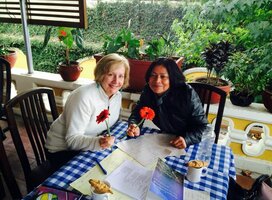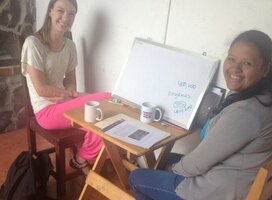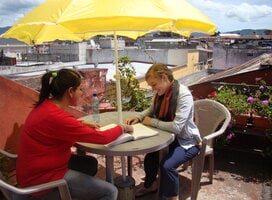Spanish Language Schools in Guatemala
Though Guatemala is not yet a fixture on Central America’s “Gringo Trail” of visitors, its educational attractions are decidedly underestimated: ancient Mayan ruins, hundreds of endangered species and a spoken Spanish that even beginners will understand.
Like the rare Quetzal bird represented by its national currency, Guatemala is a vibrant creature; a country determinedly surviving successive periods of foreign colonization and bloody civil strife. Colored by a myriad of indigenous cultures with long histories, this has often been considered an endangered region that only achieved environmental and political stability in the mid-1990s. Its three UNESCO World Heritage sites, two Nobel Prize winners and five distinct ecosystems are proof that while dominating powers may change, Guatemala, itself, remains.
Because Guatemala is not home to large tourist and expat populations, you will be forced to use the language in daily activities, from catching the bus to buying supplies at the neighborhood market.
Luckily, the locals are hospitable and will help you in your efforts to speak Spanish as easily as they do themselves. One of the greatest benefits? Guatemala’s central location, tucked like a taco ingredient between two continents of Spanish-speaking countries. What further incentive could you want for learning Spanish in Guatemala?
Guatemalan Spanish speakers are renowned for their neutral accent. The country’s Spanish vocabulary is rich with cultural influences, yet lacks the regional slang that clutters up the language in other countries. And, due to the abundance of programs and relatively low costs, studying in Guatemala offers travelers a modicum of flexibility unusual for most study-abroad programs.
If you’re hoping to acquire basic language proficiency for further travels, consider a shorter-term program that pairs immersion activities or a homestay accommodation with coursework. If advancing to a level of fluency tops your to-do list, consider a more intensive, long-term university program. Here’s some advice to help you pick the right language program:
Private Tutoring
This encourages personal growth and confidence in Spanish. Having the full-time attention of one person, typically a native Spanish speaker or certified teacher, is helpful for both beginning learners and those wishing to build upon previous Spanish instruction.
Private tutors are arranged through language schools, which aim to match a student’s needs with a teacher’s style. Tutoring sessions typically run 20 hours a week, for a minimum two-week period of study.
- Pros: allows for faster development of language; flexible course duration.
- Cons: less interaction with other students; potential for conflict between student and teacher.
Group Courses
A comfortable option for beginning Spanish speakers, small group courses provide you with associates at a shared level of learning. Group sizes typically max out at ten students, and are convenient for backpackers and students traveling with friends.
On top of the 20-30 hours spent in the classroom each week, groups participate in organized immersion activities, such as weekend field trips and nightly bonding events.
- Pros: collective environment for making and learning from mistakes; instant relationships with other students.
- Cons: less flexible course duration; less focus on individual language growth.
Language Study & Cultural Immersion Programs
For the multi-tasker, these programs can be an alluring alternative to the traditional classroom experience. Spanish language study usually occurs for two hours a day, with another two or more hours spent practicing a unique skill.
From surfing and yoga, to Salsa dancing or Guatemalan cooking, these programs promote un poco de todo; that is, “a little bit of everything.”
- Pros: learn more than a language; involvement in specific immersion activities.
- Cons: less focus on language; language development limited to a specific subject.
HIGHLIGHTS
- Check out the crowd: While 60 percent of the population speaks Spanish, this is just one of over 50 languages used in the country.
- Did you know... Scenes from the Star Wars film, A New Hope, were filmed in Tikal National Park.
- School’s out, let’s have some fun: Rumor has it there are hundreds of tamale flavors in Guatemala; order one at every comedore, or eatery, in town and start counting…
- Wow others with an idiom! Cuando eras huevo, yo ya volaba; literally, “When you were an egg, I was flying,” a humble reminder that you’re less experienced than the person speaking to you.
Antigua, Guatemala
One of the country’s UNESCO heritage sites, the name of this Spanish colonial city literally means “ancient”. While cobblestone alleys and narrow canals are reminiscent of an antiquated European city, the average age of tourists infuses the coastal city with a spirit of youthful enthusiasm.
A popular destination for visitors and expatriates, Antiqua’s well-organized tourism industry creates easy access to the city’s social scene and surrounding cultural activities. However, for students craving a bit more grass-roots experience, Antiqua’s international renown can prove a challenge to finding personal, non-English, immersion experiences.
Quetzaltenango, Guatemala
Shortened to Xela, the country’s second-largest city draws mixed opinions from the mouths of students. For some, the centralized location, noticeable lack of Western traffic and large indigenous population create a more authentic learning environment.
A municipal theatre and natural history museum provide additional cultural resources. But to other students, Quetzaltenango is a weathered old settlement tarnished by unruly rural sprawl. While its location keeps foreign numbers low, this also means students are farther from Guatemala’s must-see sights.
Qualifications
Most Guatemalan language programs are intended to meet the needs of basic and intermediate students; so don’t worry if you confuse agua with Antigua, or haven’t touched a textbook for twenty years. If you plan to study Spanish at a beginner or intermediate level, most courses do not require a student visa. Entering the country on a tourist visa -- granted to most nationalities upon arrival -- will guarantee 90 days of study and travel. If you find yourself dreaming in Spanish, make the most of your lessons and extend the visa for another 90 days.
Cultural Immersion
Few things throw you into the heart of a country like a homestay with a local family. And that’s how nearly all Spanish schools accommodate students: in the beds, bathrooms and kitchens of hospitable citizens -- some who may not speak any English!
In this way, you’re practicing daily conversational skills while your host mother stuffs you with chiles rellenos. Families will proudly invite you along to community events. Additional program-organized field trips often include a hike up one of Guatemala’s 30-plus volcanoes, an exploration of Tikal National Park and a trip to the beach.
Financial Costs
Nearly every Spanish study program is paid on a week-by-week basis. Costs usually cover minimal study materials -- handouts and notebooks -- as well as accommodation and meals. Because most programs place students in homestays, a portion of your weekly fee should go into the pockets of your host family.
Unfortunately, costs don’t always return to the locals who feed and shelter you; double-check the specifics of your study fees before committing to a homestay situation. Immersion trips are not typically included with course fees; but, because Guatemala has cheap public transportation, these shouldn’t cost much -- and tend to be experiences worth every centavo, or cent.
Scholarships
Due to the relatively low costs of studying Spanish in Guatemala, few programs offer scholarships for students. However, if you have finances to share, several community-based language schools are now offering Spanish courses and converting your fees into scholarships for local children to learn English.






